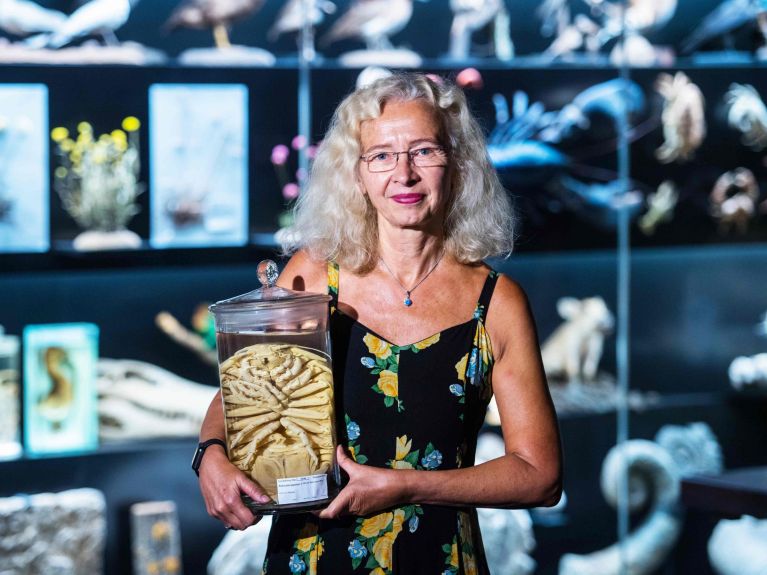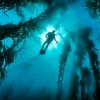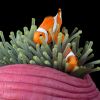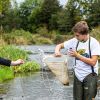“The deep sea is home to a world that is completely unknown”
Deep-sea research: Angelika Brandt received a prestigious Japanese award for her work examining organisms on the seabed.

Angelika Brandt is fascinated by the creatures of the seabed that live deep in the sea. The deep-sea researcher whose work focusses mainly on crustaceans such as isopods has conducted many expeditions to find out more about these organisms. These international team expeditions with research vessels can last several weeks or even months at a time. Special equipment is used to extract the animals from the sea, clean away any mud and examine them. Angelika Brandt has described 119 new species, 22 new genera and three new families, as well as three suborders to date. 22 species were even named after her by international researchers. This honour is rarely bestowed on scientists while still alive. Born in 1961 in Minden in Westphalia, Angelika Brandt is a lecturer at the Goethe University Frankfurt am Main and leader of the marine zoology department of the Senckenberg Nature Research Society. She thinks of such recognition as an appreciation of her work and findings on life and the organisms in the deep-sea territories which she has explored.
To receive the award was a very special moment in my life.
Special recognition was conferred on her in the form of a prestigious award: in 2024, Angelika Brandt was the first German scientist to receive the International Prize for Biology of the Japan Society for the Promotion of Science (JSPS). “It was a very special moment in my life,” she said when asked about the moment she learned that she had been selected for the award. In December 2024, Brandt travelled to Japan to accept the lifetime achievement award. The Crown Prince and Crown Princess Akishino attended the award ceremony.
Working with international teams
During her expeditions, Brandt has always worked with Japanese researchers, too. “In 2023 I was invited to join an expedition to the Japan Trench and the Kuril–Kamchatka Trench on the research vessel Hakuho Maru. This expedition is now giving rise to first-rate data,” she reports. In the Kuril–Kamchatka Trench the researchers were able to take samples at depths of up to 9,600 metres. “The equipment and the winch on the research vessel are stretched to their technical limits in the deep sea,” Brandt says. She explains that the winch must start slowly to be able to pull up the deep sea cable that is used to lower the collection equipment. A choppy sea can make the work harder, too.
Dieses YouTube-Video kann in einem neuen Tab abgespielt werden
YouTube öffnenThird party content
We use YouTube to embed content that may collect data about your activity. Please review the details and accept the service to see this content.
Open consent formIn the Antarctic Ocean Angelika Brandt encountered a different type of challenge: “You cannot take any samples where there is ice,” she says. Nevertheless, she did observe an extremely high degree of biodiversity in the deep sea here. “These groundbreaking findings were very surprising even for us researchers.” The marine biologist explains the proportions: “Our Earth has a surface area of 512 million square kilometres, and 352 million square kilometres thereof are accounted for by the deep sea. The samples we have taken to date cover less than one millionth thereof. The deep sea is a completely unknown world about which we know near to nothing.” Brandt has been able to shed a little bit of light onto this darkness.

Why do animals live there and how? How are they distributed geographically? Which environmental factors determine the presence of species? These are some of the research questions she addresses. She explains that this information is important in the context of climate change and human interference with the environment. “Us humans have been altering this planet to an extreme extent,” Brandt points out. “Climate change, storms, rising sea levels and temperatures, melting glaciers: all of this is linked to our oceans, and we have no idea what lives in them and what are the functions of such species in the ecosystem.”
Fascinated by the sea
Brandt did not initially plan to become a researcher. She originally wanted to be a teacher, so she studied education and biology at university. However, during her studies she was part of a working group that examined isopods. She also learned to dive and trained as a research diver. “All of a sudden a window opened into a world I had always been fascinated by,” says Brandt, who loved to watch films about the underwater world, even as a child.
She became more and more curious about science. While she was working on her doctoral thesis, she took part in a number of expeditions, including a diving expedition in Antarctica. “It was a male domain at the time,” Brandt recalls. “There were no dry suits that fit petite women such as myself and the company that was supposed to make bespoke suits for us cancelled three weeks before the expedition.” Brandt went to a shop and bought the smallest men's suit available, but it was still too big for her. “I had to stuff the feet area with padding.” Brandt remained fascinated by the sea and its creatures, despite these challenges. Nowadays she is both: a university teacher and a deep-sea researcher.



